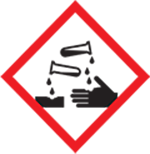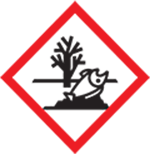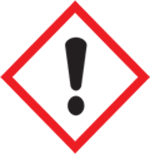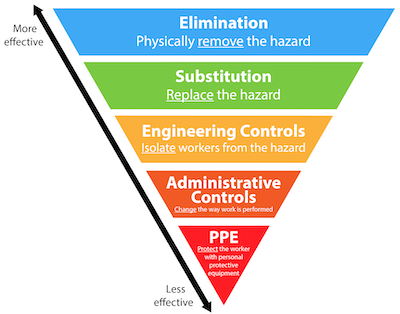Ammonia Solution
This chemical standard operating procedure (SOP) and the associated Safety Data Sheet (SDS) are for our safety. Read and understand both documents. If this is a paper copy, check for updated versions on the IsoLab website.
Process
Ammonia solution (also known as aqueous ammonia or ammonium hydroxide) is used in the Chromium Reduction protocol to capture H2S.
Hazards - SDS



Harmful if swallowed. Causes severe skin burns and eye damage. May cause respiratory irritation. Very toxic to aquatic life.
Protection - SDS

Engineering Controls
Ammonia solution is to be used in one of the fume hoods in the 302 / 303 suite. Ensure the fume hood has appropriate flow prior to working with ammonia solution. Do not work with ammonia solution unless the fume hood is functioning properly. Ensure the fume hood has proper air flow by checking the flow rate on the control panel and / or using a smoke match or wipe to visualize flow.
PHS - Ammonia solution may only be used in a fume hood. Preferably the fume hood directly above its storage location.
Administrative Controls
PHS - Tell others in the lab that you are using ammonia solution. Do not allow anyone else to work in the same fume hood while you are working with ammonia solution unless they are working with you. If you must leave the fume hood for any period of time, close the sash and tape a sign up indicating the presence of ammonia solution.
Personal Protective Equipment (PPE)
PHS - While working with ammonia solution in a fume hood you should be wearing nitrile gloves, a laboratory coat, and safety glasses with side shields (or goggles) and a face shield.
Handling - SDS
Ammonia solution is stored in the corrosives cabinet under the west fume hood in 303B. Make sure you have your laboratory coat, eye protection, and gloves on before handling the bottle. Consider making a working solution container so that the stock bottle can remain tightly closed and in the corrosives cabinet.
PHS - Decontamination - Any glassware that has been used with ammonia solution should be rinsed such that the first rinse goes into your waste container. Subsequent rinsing or washing of glassware can be done outside the fume hood in the sink as per normal lab glassware cleaning procedures.
Storage - SDS
In general, ammonia solution must be stored below eye level, in a corrosives compatible vented cabinet under a fume hood. Use MyChem, the UW EH&S chemical inventory database, for more information on where in the lab suite this chemical is stored. We have identified the Corrosives cabinet under the west fume hood in 303B for ammonia solution to be stored in their secondary container.
Spills - SDS
Outside Fume Hood Spill - FUMES - Everyone should evacuate. If you intend to clean up the spill yourself, don a respirator with an ammonia cartridge and non-vented protective goggles before attempting clean-up. Do not let anyone enter the contaminated space until the air is cleared or proper PPE has been donned.
PHS - Exposure:
- Inhalation - Move to fresh air. For advice, call UW Employee Health Center (206.685.1026) or the Washington Poison Center (800.222.1222). For emergency help, call 911.
- Skin contact - Rinse with plenty of water for at least 15 minutes while removing contaminated clothing and shoes. For advice, call UW Employee Health Center (206.685.1026) or the Washington Poison Center (800.222.1222). For emergency help, call 911.
- Eye contact - Immediately flush with plenty of water for at least 15 minutes. If easy to do, remove contact lenses. For advice, call UW Employee Health Center (206.685.1026) or the Washington Poison Center (800.222.1222). For emergency help, call 911.
Inside Fume Hood Spill - If the spill is fully contained inside the fume hood, close the sash and prepare yourself to clean it up. Grab the closest spill kit. Make sure you have the appropriate PPE on (lab coat, nitrile gloves, eye protection). Do not allow the substance to enter the drain. Use liquid-absorbent material to soak up the chemical. Put all generated waste into a bag. See Waste section below.
If you need assistance or advice, use the IsoLab Emergency Contacts sheet.
Consult the EH&S Spill Poster and Exposure Poster
Waste - SDS
If you are cleaning up after a spill and have a bag of debris, ensure the bag is sealed and use multiple bags as needed. Complete an EH&S Hazardous Waste Label and adhere it to the bag. Here are instructions for how to label chemical waste containers. Labels are located in a drawer on the west wall of 303B near the door to the hallway.
If you are cleaning up after routine work, put all waste, solid or liquid, into a container. Options for waste containers can be found under the west sink in 303B. Complete an EH&S Hazardous Waste Label and adhere it to the bottle. Here are instructions for how to label chemical waste containers. Labels are located in a drawer on the west wall of 303B near the door to the hallway.
Place the properly labeled container in one of the gray tubs near the hallway door of 303B. Segregate from other waste containers as appropriate.
Consult our generalized Chemical Waste Disposal SOP.

Training - PHS
Ammonia solution is deemed a particularly hazardous substance - PHS by EH&S and you need approval before using it. Complete the list of requirements below before using this chemical.
Prerequisites
- You must have completed Managing Laboratory Chemicals in the last three years. Login to check.
- Read and understand the SDS for ammonia solution.
- Read, understand, and digitally sign this SOP.
- Contact your Principal Investigator (PI) AND the Chemical Hygiene Officer (CHO) indicating that you have completed all prerequisites and await approval.
